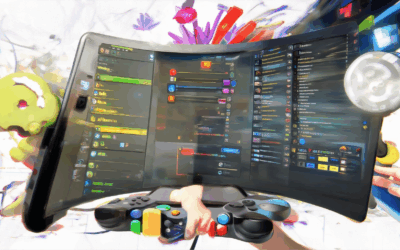Designing game levels is a crucial aspect of creating engaging and immersive experiences for players. Whether you’re working on a puzzle game, a platformer, or an open-world adventure, crafting levels that challenge, entertain, and resonate with your audience requires a blend of creativity, technical expertise, and a deep understanding of player behavior. From selecting the right tools and software to maintaining thematic consistency and optimizing player engagement, every decision in level design contributes to the overall success of a game. In this article, we’ll explore the essential tools and software for level design, strategies for ensuring thematic coherence across different levels, and proven methods for enhancing player interaction and immersion. By leveraging feedback, collaborating effectively with teams, and staying ahead of future trends in level design, you can create levels that not only challenge players but also provide a cohesive and rewarding experience that keeps them coming back for more.
Final Answer:
Creating engaging and progressively challenging game levels involves several key steps, each contributing to a cohesive and immersive player experience. Here’s a structured approach:
- Define the Theme: Begin by clearly identifying the game’s central theme. Ensure every level reflects this theme through visuals, music, and gameplay mechanics. For example, a space adventure might feature futuristic elements and sci-fi themes.
- Progressive Difficulty Curve: Design levels that introduce new challenges incrementally, building on the player’s skills. Use analytics to monitor performance and adjust challenges based on player behavior.
- Utilize Development Tools: Employ tools like Unity or Unreal Engine for creating visually appealing and interactive environments. Utilize tutorials and guides to become familiar with these tools.
- Implement Feedback Loops: Conduct regular playtests to gather player feedback, adjusting levels to address ease of access and challenge. Consider playtesting as an ongoing process rather than a single event.
- Visual Storytelling: Use color schemes, lighting, and environmental cues to enhance the narrative. In a horror game, a dark environment can set the appropriate mood without being intrusive.
- Design Progression Systems: Create a reward system that includes both extrinsic rewards (like coins) and intrinsic rewards (like puzzle solutions). Ensure progression feels meaningful and fair.
- Study Competitor Games: Analyze successful games to gain insights into effective level design, while maintaining your game’s unique theme and vision.
- Ensure Accessibility and Fairness: Balance difficulty with checkpoints and clear visual cues to avoid frustration. Maintain a fair challenge that is rewarding.
- Leverage Analytics and Data: Monitor player metrics like completion rates and failure points to refine level designs and ensure they meet player expectations.
- Collaboration and Process: Work closely with designers and developers, breaking tasks into manageable parts from objective setting to environment design.
By following these steps, you can create engaging, balanced, and consistently themed game levels that captivate players and provide a cohesive experience.

Creating Engaging and Progressively Challenging Game Levels
To create engaging and progressively challenging game levels that fit seamlessly into a game’s theme, follow these steps:
- Define the Theme and Style : Start by clearly understanding your game’s theme and style. Whether it’s a fast-paced action game, a relaxing puzzle adventure, or an intense survival horror experience, ensure every level reflects this theme. Incorporate unique visual elements, sounds, and gameplay mechanics that resonate with the overall game identity.
- Design Progressively Increasing Challenges : Create a balanced progression system where each level introduces new challenges that build upon the player’s skills and knowledge. This ensures that players feel constantly challenged and motivated to improve.
- Utilize Appropriate Development Tools : Leverage tools like Unity, Unreal Engine, or GameMaker Studio to design visually appealing and interactive environments. These tools offer robust scripting capabilities, allowing you to implement complex mechanics and efficiently manage assets.
- Implement Feedback Loops : Conduct regular playtests to gather player feedback. Use this feedback to refine level design, adjust difficulty curves, and ensure that the player experience remains enjoyable and rewarding.
- Create Visual Storytelling Elements : Integrate visual storytelling into your levels. Use color schemes, lighting effects, and environmental cues to guide players through the narrative. Consider adding NPCs or objects that provide hints or clues to enhance immersion.
- Develop a Cohesive Progression System : Design a progression system that rewards players for overcoming challenges. This could include unlocking new abilities, accessing secret levels, or earning achievements. Ensure that the progression feels meaningful and encourages continued play.
- Study Competitor Games : Analyze successful games in your genre to understand how they create engaging levels. While staying true to your own vision, draw inspiration from effective mechanics and design patterns observed in competitors like Dark Souls or The Legend of Zelda.
- Ensure Accessibility and Fairness : Balance difficulty with accessibility. Make sure that challenging levels are fair and rewarding, avoiding frustrating encounters. Implement checkpoint systems, save points, and clear visual cues to help players navigate difficult sections.
- Leverage Analytics and Data : Use analytics tools to monitor player behavior and performance. Track metrics like completion rate, time spent, and failure points to identify areas that may need adjustment. Use this data to iteratively improve your level designs and ensure they align with player expectations.
By following these guidelines, you can create engaging and progressively challenging game levels that not only fit your game’s theme but also provide an exceptional player experience.
Essential Steps to Design Game Levels That Keep Players Engaged and Maintain a Consistent Theme
To design game levels that keep players engaged and maintain a consistent theme, follow these essential steps:
- Understand Your Audience : Begin by understanding your target audience’s preferences, skills, and interests. Consider factors like age, gender, and gaming experience to tailor level design choices. https://indiedevgames.com/tutorials/understanding-your-audience/
- Create Varied Yet Consistent Objectives : Design levels with clear, varied, and progressively challenging objectives. Ensure these objectives align with your game’s theme and reward players appropriately. https://indiedevgames.com/tutorials/game-objectives/
- Iterate Based on Feedback : Test your levels with real players to gather feedback. Use tools like surveys, interviews, or beta testing to identify what works and what doesn’t. https://indiedevgames.com/tutorials/beta-testing/
- Engage Visual and Auditory Elements : Use high-quality visuals, animations, and sound effects to immerse players in your game’s theme. Create a cohesive atmosphere that reinforces the game’s identity. https://indiedevgames.com/tutorials/visual-design/
- Implement Positive Reinforcement : Reward players with points, achievements, or unlockable content to keep them motivated. Ensure these rewards align with your game’s theme and encourage continued play. https://indiedevgames.com/tutorials/rewards-system/
- Analyze Performance : Track player performance metrics like completion rates, session length, and drop-off rates. Use this data to refine your level design and improve overall player engagement. https://indiedevgames.com/tutorials/analytics/
- Balance Difficulty Curve : Create a balanced difficulty curve that challenges players without frustrating them. Test and iterate to find the optimal challenge level that keeps players engaged. https://indiedevgames.com/tutorials/difficulty-balance/
- Cross-Promote Within the Game World : Tie levels together by referencing previous levels, characters, or storylines. This creates a sense of continuity and helps players stay invested in the game’s world. https://indiedevgames.com/tutorials/world-building/
By following these steps, you can create engaging and thematically consistent game levels that keep players hooked and enhance their overall gaming experience.

Creating Engaging and Progressively Challenging Game Levels
To create engaging and progressively challenging game levels that fit seamlessly into a game’s theme, follow these steps:
- Define the Theme and Style : Start by clearly understanding your game’s theme and style. Whether it’s a fast-paced action game, a relaxing puzzle adventure, or an intense survival horror experience, ensure every level reflects this theme. Incorporate unique visual elements, sounds, and gameplay mechanics that resonate with the overall game identity.
- Design Progressively Increasing Challenges : Create a balanced progression system where each level introduces new challenges that build upon the player’s skills and knowledge. This ensures that players feel constantly challenged and motivated to improve.
- Utilize Appropriate Development Tools : Leverage tools like Unity, Unreal Engine, or GameMaker Studio to design visually appealing and interactive environments. These tools offer robust scripting capabilities, allowing you to implement complex mechanics and efficiently manage assets.
- Implement Feedback Loops : Conduct regular playtests to gather player feedback. Use this feedback to refine level design, adjust difficulty curves, and ensure that the player experience remains enjoyable and rewarding.
- Create Visual Storytelling Elements : Integrate visual storytelling into your levels. Use color schemes, lighting effects, and environmental cues to guide players through the narrative. Consider adding NPCs or objects that provide hints or clues to enhance immersion.
- Develop a Cohesive Progression System : Design a progression system that rewards players for overcoming challenges. This could include unlocking new abilities, accessing secret levels, or earning achievements. Ensure that the progression feels meaningful and encourages continued play.
- Study Competitor Games : Analyze successful games in your genre to understand how they create engaging levels. While staying true to your own vision, draw inspiration from effective mechanics and design patterns observed in competitors like Dark Souls or The Legend of Zelda.
- Ensure Accessibility and Fairness : Balance difficulty with accessibility. Make sure that challenging levels are fair and rewarding, avoiding frustrating encounters. Implement checkpoint systems, save points, and clear visual cues to help players navigate difficult sections.
- Leverage Analytics and Data : Use analytics tools to monitor player behavior and performance. Track metrics like completion rate, time spent, and failure points to identify areas that may need adjustment. Use this data to iteratively improve your level designs and ensure they align with player expectations.
By following these guidelines, you can create engaging and progressively challenging game levels that not only fit your game’s theme but also provide an exceptional player experience.

Creating Engaging and Progressively Challenging Game Levels
To create engaging and progressively challenging game levels that fit seamlessly into a game’s theme, follow these steps:
- Define the Theme and Style : Start by clearly understanding your game’s theme and style. Whether it’s a fast-paced action game, a relaxing puzzle adventure, or an intense survival horror experience, ensure every level reflects this theme. Incorporate unique visual elements, sounds, and gameplay mechanics that resonate with the overall game identity.
- Design Progressively Increasing Challenges : Create a balanced progression system where each level introduces new challenges that build upon the player’s skills and knowledge. This ensures that players feel constantly challenged and motivated to improve.
- Utilize Appropriate Development Tools : Leverage tools like Unity, Unreal Engine, or GameMaker Studio to design visually appealing and interactive environments. These tools offer robust scripting capabilities, allowing you to implement complex mechanics and efficiently manage assets.
- Implement Feedback Loops : Conduct regular playtests to gather player feedback. Use this feedback to refine level design, adjust difficulty curves, and ensure that the player experience remains enjoyable and rewarding.
- Create Visual Storytelling Elements : Integrate visual storytelling into your levels. Use color schemes, lighting effects, and environmental cues to guide players through the narrative. Consider adding NPCs or objects that provide hints or clues to enhance immersion.
- Develop a Cohesive Progression System : Design a progression system that rewards players for overcoming challenges. This could include unlocking new abilities, accessing secret levels, or earning achievements. Ensure that the progression feels meaningful and encourages continued play.
- Study Competitor Games : Analyze successful games in your genre to understand how they create engaging levels. While staying true to your own vision, draw inspiration from effective mechanics and design patterns observed in competitors like Dark Souls or The Legend of Zelda.
- Ensure Accessibility and Fairness : Balance difficulty with accessibility. Make sure that challenging levels are fair and rewarding, avoiding frustrating encounters. Implement checkpoint systems, save points, and clear visual cues to help players navigate difficult sections.
- Leverage Analytics and Data : Use analytics tools to monitor player behavior and performance. Track metrics like completion rate, time spent, and failure points to identify areas that may need adjustment. Use this data to iteratively improve your level designs and ensure they align with player expectations.
By following these guidelines, you can create engaging and progressively challenging game levels that not only fit your game’s theme but also provide an exceptional player experience.
Designing Game Levels for Consistent Challenge and Cohesive Theme
To design game levels that consistently challenge players while maintaining a cohesive theme and providing an engaging experience, follow these key principles:
- Balance Difficulty and Progression : Ensure each level presents a meaningful challenge that aligns with the player’s current skill level and progression. Introduce new mechanics or increased complexity gradually to keep players engaged without overwhelming them.
- Integrate Theme Elements : Every level should reflect and reinforce the game’s overarching theme. Use visuals, sounds, and objectives that tie back to the cohesive narrative or style of the game.
- Provide Clear Feedback : Offer immediate and clear feedback to players about their performance. This can be achieved through visual cues, audio effects, or on-screen indicators that communicate success or failure.
- Encourage Skill Development : Allow players to grow and evolve their skills as they progress through the levels. This can be done by introducing new tools, abilities, or challenges that require them to adapt their strategies.
- Offer Variety in Challenges : Mix different types of challenges within the same theme to keep the experience fresh and dynamic. This can include puzzle-solving, combat scenarios, exploration, or racing elements.
- Leverage Environmental Storytelling : Use the environment to convey the theme and guide players. Place clues, obstacles, or secrets within the levels that contribute to the overall story and enhance immersion.
- Implement Progression Systems : Create a system that rewards players for overcoming challenges. This can include unlocking new levels, earning upgrades, or achieving milestones that provide a sense of accomplishment.
- Test and Iterate : Gather feedback from players and analyze performance data to refine levels and ensure they provide a satisfying experience. Adjust difficulty curves, introduce new mechanics, and iterate based on player needs.
By focusing on these principles, you can create a series of levels that not only challenge players but also immerse them in a cohesive and engaging world.

How to Design Game Levels for Balance, Theme Consistency, and Player Engagement
To design game levels that effectively balance challenge, maintain theme consistency, and keep players engaged, follow these organized steps:
- Define Core Theme and Objectives : Begin by establishing a clear central theme that will guide the level design. Ensure every level reinforces this theme through visuals, music, and gameplay mechanics.
- Progressive Difficulty Curve : Create a difficulty progression that gradually increases, allowing players to grow with the game. Use analytics tools to monitor player behavior and adjust challenges accordingly.
- Diverse Mechanics : Incorporate a variety of gameplay elements such as puzzles, combat, and exploration to maintain interest. Ensure these mechanics complement the theme without overshadowing it.
- Reward System : Implement an effective reward system that includes both extrinsic rewards (like coins) and intrinsic rewards (like satisfying puzzle solutions) to boost engagement.
- Consistent Pacing and Dynamics : Keep the game pace dynamic to prevent boredom. Use tools like Unity or Unreal Engine to create layered levels and apply procedural generation for varied experiences while preserving theme consistency.
- Iterative Testing and Feedback : Continuously test levels with players to gather feedback and refine challenges. Use analytics to identify drop-off points and make necessary adjustments.
- Collaboration and Process : Work closely with designers and developers to ensure alignment. Break down the level design process into manageable tasks, from setting objectives to environment design and mechanic implementation.
- Leverage Resources and Tools : Utilize platforms like Indie Dev Games for tutorials, reviews, and tips tailored for indie developers. These resources can enhance your design process and provide valuable insights.
By following these steps, you can create engaging, balanced, and consistently themed game levels that captivate players and provide a cohesive experience.
Conclusion
Balancing challenge, theme consistency, and player engagement in game levels requires a thoughtful approach involving clear thematic direction, progressive difficulty, diverse mechanics, and ongoing feedback integration. By employing effective tools and collaborating closely with your team, you can design levels that delight and retain players, ensuring your game stands out in the market.




0 Comments